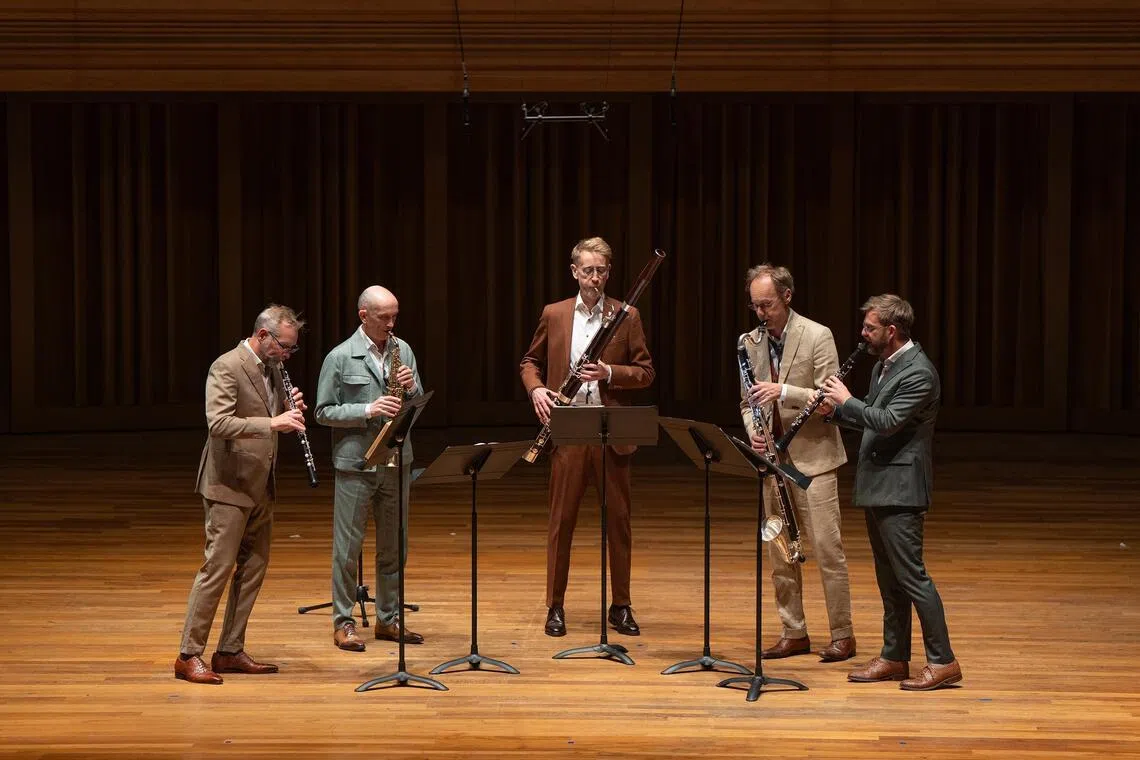Concert review: Calefax Reed Quintet a unique take on the wind ensemble
Sign up now: Get ST's newsletters delivered to your inbox

Comprising musicians (from left) Oliver Boekhoorn, Raaf Hekkema, Alban Wesly, Jelte Althuis and Bart de Kater, Calefax Reed Quintet put on a concert at the Conservatory Concert Hall on Sept 12.
PHOTO: LUCAS KWAI MING YANG
Chang Tou Liang
Follow topic:
Calefax Reed Quintet In Recital
Conservatory Concert Hall
Sept 12, 7.30pm
The Netherlands is famous for wind ensembles, and they do not come as unique as Calefax Reed Quintet, which celebrates its 40th anniversary in 2025.
Founding members Raaf Hekkema (saxophone) and Alban Wesly (bassoon), joined by Oliver Boekhoorn (oboe), Bart de Kater (clarinet) and Jelte Althuis (bass clarinet), showed in 90 minutes how their special sound defined the genre and has spawned many imitators.
Having replaced the flute and French horn of traditional wind quintets with saxophone and bass clarinet, a darker and deeper sonority with an unusual mellowness is the result.
As this medium is new, almost all the works performed were transcriptions of pre-existing music. The skill was in making individual lines of each instrument stand out yet blend in a seamless manner.
The concert opened with Johann Sebastian Bach’s Aria Variata, originally written for harpsichord.
Straight off, the sheer heterogeneity of five reeds trumped the keyboard’s characteristic clatteriness in the opening aria, with the ensuing variations coming off with highlighted textures and colours. Was this an improvement? In a word, yes.
Next were two original works for pipe organ, now clothed in reedy finery by Althuis, who himself plays the organ. Cesar Franck’s Deuxieme Choral (Chorale No. 2) has seldom sounded more coherent, as the running counterpoint is more clearly delineated in this guise. Its quite memorable theme also becomes an earworm.
Coming to prominence of late is Florence Price, the first African-American woman composer to be commissioned by a major American symphony orchestra.
Her Suite No. 1 for organ comprised four appealing short movements, beginning with a Fantasy and Fughetta revealing a Bachian influence. The Air had the lament-like quality of an African-American spiritual, no doubt coloured by Czech composer Antonin Dvorak’s creations. And the dance-like Toccato (likely a misspelling of Toccata) erupted with folk-like rusticity.
Joined by conservatory students Valentino Banggul (oboe), Yang Jinliang and Tao Nuoxi (clarinets), Aden Chan Jian Shun (saxophone) and Chen Chia-Wei (contrabassoon), the 10-strong ensemble generated the biggest sound possible for Bach’s monumental Passacaglia & Fugue In C Minor (K.582), another organ piece idiomatically arranged by Althuis.
The ultra-deep bass voices of contrabassoon and bass clarinet set its plodding pace moving, with other instruments joining in piecemeal for the short variations on its ground bass. The incremental build-up of voices made this a thrilling exercise of crescendo before closing with an almighty roar.
The quintet returned with a sneak preview of Dutch composer Michel van der Aa’s Link, specially commissioned for Calefax’s quadragennial celebrations in November.
Its title is so named to link 40 worldwide reed quintets, which will perform its five brief movements in due course. Alternating fast and slow, its highly syncopated, rapid-fire repeated notes were reminiscent of Igor Stravinsky’s wind masterpieces and works of minimalism.
Following the impressive premiere of sorts was George Gershwin’s very popular An American In Paris, performed from memory and with niftily choreographed steps. Its plummiest tune was reserved for Hekkema’s irrepressible solo sax. And why not? Call this founder’s privilege.

